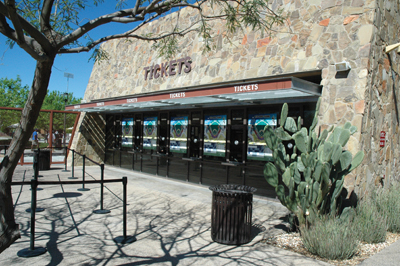The first Monday in March brought sunny skies back to Phoenix after heavy weekend rains canceled three spring training games and cut short three others. It was a beautiful day for baseball, but early in the Cactus League season, some ballparks struggle to draw fans.
Camelback Ranch, shared by the Chicago White Sox and Los Angeles Dodgers, is one example. After the Dodgers played a Sunday game before a crowd of 8,585, the Sox drew a paltry 2,662 against the Kansas City Royals. The number of fans in the park, which can hold 13,500, appeared to be much lower.
 |
Camelback’s desert-inspired theme of embedded stone and rusty metal finishes extends to the ticket windows.
Photo by: DON MURET / STAFF
|
But it’s tough to complain about much of anything on a gorgeous afternoon while taking in the sights of Camelback Ranch, the $121 million Glendale ballpark that opened in 2009.
The stadium, designed by HKS and built by Mortenson, gives off a high-end spa/resort vibe. The ballpark’s architecture is heavy on embedded stone and rusty metal finishes. The swooping roofline above the grandstand is a signature design element.
Large cactus plants decorating concession carts inside the park reinforce the desert theme. There’s a mix of Chicago and Los Angeles on the concessions side. Delaware North Sportservice, Camelback’s food provider, serves both Dodger Dogs and the Ditka monster Polish sausage.
The picnic pavilion behind center field has permanent food stands and shaded tables for fans to enjoy a sit-down meal. In that area, they can stop in at one of the stadium’s two team stores to shop for Paul Konerko shirts, celebrating the player who’s entering his 16th season wearing a White Sox uniform.
Against that backdrop, Jeff Overton, Camelback Ranch’s president and general manager, said the key to making it all work is flexibility.
“Our two teams have very different fan desires and personalities that can change game to game,” said Overton, who works for a joint venture tied to the Dodgers and White Sox. “It definitely has an effect, so how we use different pieces of the building changes from day to day.”
The newly branded Eighteen76 Legends Deck in left field reflects market demand. On weekends, group tickets for the 95-seat deck cost $59 a person, an amount that covers the cost of food and non-alcoholic beverages. For weekday games, it’s a straight $34 ticket without food and drink. The joint venture sold the deal to Budweiser on behalf of the two teams, and officials hope the new identity will help the party deck attract more group buyers. As of now, it’s been mostly single-ticket sales in that space, Overton said.
For this particular game, though, the party deck was empty, and the all-you-can-eat patio in left field was closed, reinforcing Overton’s assessment of Camelback as a Friday-to-Sunday draw in addition to the second half of spring training, when spring break kicks into high gear.
To make those early weekend games a greater attraction, ballpark management brings in former stars from the home team to sign autographs in a common area next to the practice fields before games. The alumni then visit the party deck and the 12 suites.
Ex-Dodgers Manny Mota and Tim Leary and former White Sox players Ron Kittle and Jerry Hairston have all participated in those sessions.
“It’s part of the connecting of people very closely to the product that they might not be able to get at the major league ballpark,” Overton said.
Access to players in general is a big plus at Camelback Ranch, which is connected to public pathways behind the park circling the practice fields.
Earlier in the day, several Dodgers fans hung out for autographs. Shortly before the team bus left, ESPN analyst Nomar Garciaparra, who played three years for the Dodgers, stopped on one trail to sign bats, balls and mitts.
“Spring training is for the fans, too,” Overton said. “It’s how they re-engage and get ready for the season in their own right.”




